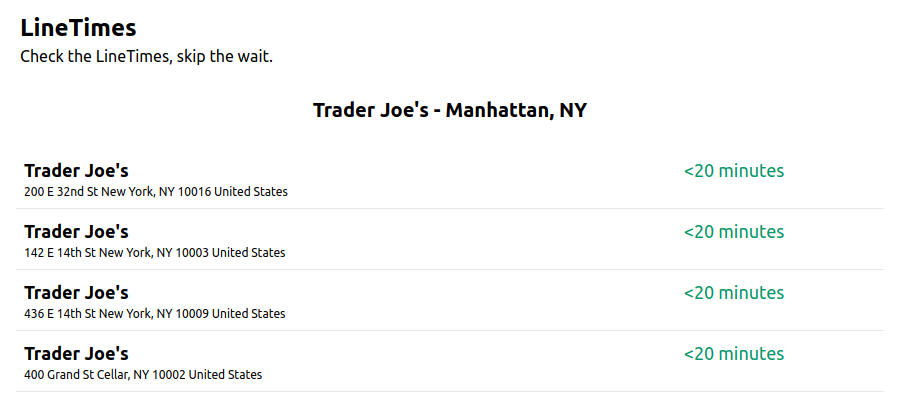Essay - Published: 2020.12.19 | business | projects |
DISCLOSURE: If you buy through affiliate links, I may earn a small commission. (disclosures)
Update: LineTimes is now dead. More info: Shutting down my first startup.
Today I'm releasing LineTimes - a site that calculates and aggregates the wait time at stores in your area.
Now live in Manhattan, NY!

LineTimes screenshot
last updated 2021.05.16
I've lived in Manhattan, NY for about 3 years now. There are a lot of great things about living in a densely populated city (in non-COVID times). We have unparalleled entertainment options, great restaurants, and the best public transportation in the United States.
But there are also some downsides like being a virus breeding ground, sky high rents, and (surprise!) extremely long waits at grocery stores.
I don't know about you but until I moved to New York, I don't think I'd ever waited in line at a store for > 30 minutes unless it was for the release of the new Halo game or Harry Potter book. But that's the thing, everybody's gotta eat and many people choose to go to the store around the same times each week cause I guess we're not so different after all?
Put that together and you get some unreasonably long lines to acquire your food prep materials in the #greatestcityonearth.
I stood in 20 / 30 / 40 minute lines at Trader Joe's for months before finally deciding I should build something to allow me to avoid those lines. I came up with the idea more than a year ago and now I'm finally releasing that to the world. 10 months into a pandemic.
Check the LineTimes, skip the wait.
At a high level, LineTimes works by looking at how many people are in the store, comparing that to historical records of how long line times were for that amount of people, and making a prediction based on that.
It's probably not the best timing on my part to release a service aimed at solving problems caused by crowds when crowds are basically illegal. But it's rarely ever the 'right' time, I've finally got it built, and am paying for compute so now seems as good a time as any.
I've opened the service up to work for Trader Joe's in Manhattan to limit the scope of the initial build to the core experience needed to validate whether this is a useful path or not. I figured that I'd only experienced this problem personally in those stores so if other people didn't think it was a problem in those same stores then it's likely not worth pursuing.
In entrepreneurship I think this is called problem validation. This is supposed to be a fast, cheap process to make sure you're working on something valuable. Assessing myself, I think I spent way more time trying to get this launched than I should have. A lot of that was spent learning new technologies and thinking about how to keep my business processes lean. I think I would've had to bite that bullet eventually as I figured out how I wanted to build and run my businesses but it still hurts a bit to see the number of hours put in vs the output I was able to create.
Still I understand that it's a learning process and that this is truthfully the first real 'business' I've ever launched - despite saying I was going to be building a business each month for literal months. So I think it's important to cut myself a little slack, be grateful I was able to launch, and to make changes so I can be better next time.
If you've got a few minutes, I'd really appreciate it if you could click around LineTimes and send me any feedback you may have!
I knew I wanted to pick a technology stack that was simple, would just work, that I'd enjoy working in, and that would be flexible and scalable enough to work for pretty much any business / idea I could think of. I knew that the learning process would be long so I wanted to make sure that whatever I learned had a high likelihood of high utilization down the road. Through these criteria I figured I could find a nice balance of efficiency, satisfaction, and power to build my projects on top of.
My tech stack:
Pretty much all of the time cost for this project was spent building the software and the money cost goes towards running it on Google Cloud. It took me a lot of time to ramp up on each of these technologies as I hadn't built anything significant in them in several months if ever. On the bright side I think that investment was well worth it and will pay dividends as I build more projects in the coming months.
My current plans are to 1) validate whether people find LineTimes useful and, if so, 2) build additional features to help them avoid long wait times. While I'm doing that I'll be spinning up some new businesses and throwing in some new art to spice things up as we roll into the new year.
In art and business.
-HAMY.OUT
The best way to support my work is to like / comment / share for the algorithm and subscribe for future updates.